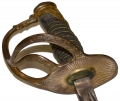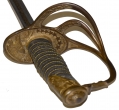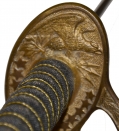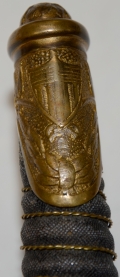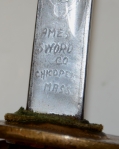site search
online catalog
MODEL 1872 CAVALRY OFFICER’S SABER BY AMES

$950.00 SOLD
Quantity Available: None
Item Code: 1047-16
This pattern of cavalry officer’s saber was adopted in 1872 and was regulation for thirty years until the 1902 pattern officer’s sword was adopted for all branches of service. As shown by this sword, owned by an infantryman, the cavalry officer’s saber was often preferred by other branches of service to the 1872 staff and field sword, likely because it looked like you could actually do some damage with it.
This is a nice example by Ames. The brass hilt features a pommel cap with floral decoration and a U.S. shield on its face with crossed sabers underneath. The guard is the standard three-branch cavalry guard, decorated with cast laurel leaves, and the interior of the counterguard is cast with an American eagle crouching and perched at the top of the interior clutching arrows and an olive branch, with a row of stars around the lower edge. The outside of the guard has a burst of sun rays radiating outward. The grip is sharkskin wrapped and bound with twisted brass wire. The surface of the gray sharkskin shows some light wear on the raised portions from handling.
The blade is the correct, slightly curved single edged blade with false edge, that is lighter version of the 1860 pattern. The “Ames Sword Co. Chicopee Mass” address is etched on the obverse ricasso. Interlocking foliate geometric designs border two panels, the lower of which has an eagle with spread wings and an U.S. shield, with an E Pluribus Unum ribbon underneath, and the upper has a somewhat more detailed U.S. shield. The reverse is etched also with two panels set off by the interlocking geometric scrolls. The upper panel contains a tall trophy of arms with halberd, flags, and curved Roman shield. The lower panel is etched with the owner’s name and unit: “Paul J. Norton / 2nd Regt. Infantry M.V.M.”
Norton was from Springfield and is listed as the regiment’s sergeant major for the period of 1897-1898. He does not seem to have gone to Cuba with the regiment, but rather to have gained a commission as first lieutenant of the 27th Company of Massachusetts Provisional Militia in 1898. He then rejoined the 2nd Infantry as first lieutenant and a battalion adjutant in 1900. The sword likely dates to this last appointment, where he was not only an officer, but likely to serve mounted.
These sabers are often poorly preserved. This one is a cut above. The brass hilt has a nice mellow patina. The steel scabbard retains all its original blue and the brass throat, ring mounts, and drag retain lots of their gilt wash, which really sets off the mounts. The blade is smooth metal with a good edge and point. There are no nicks or gray spots and it is bright steel above the etched panels. Best of all, the etching is vivid. This is a very good example of a regulation U.S. saber by the most well known American sword maker. [sr]
~~~~~~~~~~~~~~~~~~~~~~~~~
THIS ITEM, AS WITH ALL OTHER ITEMS AVAILABLE ON OUR WEB SITE,
MAY BE PURCHASED THROUGH OUR LAYAWAY PROGRAM.
FOR OUR POLICIES AND TERMS,
CLICK ON ‘CONTACT US’ AT THE TOP OF ANY PAGE ON THE SITE,
THEN ON ‘LAYAWAY POLICY’.
THANK YOU!
Inquire About MODEL 1872 CAVALRY OFFICER’S SABER BY AMES
For inquiries, please email us at [email protected]
Most Popular
Historical Firearms Stolen From The National Civil War Museum In Harrisburg, Pa »
Theft From Gravesite Of Gen. John Reynolds »
Cavalry Carbine Sling Swivel »
Fine Condition Brass Infantry Bugle Insignia »
featured item
OFFICER’S FROCK COAT OF BREVET MAJOR GENERAL JOSEPH K. BARNES, SURGEON GENERAL OF THE U.S. ARMY 1864-1882
This would be the centerpiece of any medical collection: the Major General’s frock coat of Surgeon General Joseph K. Barnes. Barnes was born in Philadelphia in 1817, studied medicine at Harvard, under US Navy Surgeon General Harris, and received… (1179-579). Learn More »







